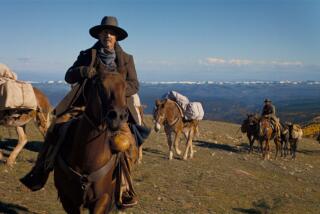Book Review : Winning the West: Myth and Reality
- Share via
The Legacy of Conquest: The Unbroken Past of the American West by Patricia Nelson Limerick (Norton: $17.95; 348 pages)
I spent most of my career in journalism working for a magazine that purported to explain what was new about the West--an endeavor that has long sustained the work of miscellaneous novelists, journalists and historians. By the time I abandoned magazine journalism for the law, I was convinced that the West is pretty much like everywhere else in America, only more so. That’s the premise of “The Legacy of Conquest,” a survey of revisionist Western historiography by Patricia Limerick, a professor at the University of Colorado. “In the second half of the 20th Century,” she writes, “every major issue from ‘frontier’ history has reappeared in the courts or in Congress.”
The West was never as wild as its propagandists would have us believe, Limerick insists; and, anyway, its essential characteristics have never really changed. And Limerick urges us to regard conquest--of land, resources and people--as the key to understanding the West. “Reorganized, the history of the West is a study of a place undergoing conquest and never fully escaping its consequences. . . . The processes of Western development do run continuously from past to present, from mining, cattle raising and farming on to hydroelectric power and even into space.”
The West, according to Limerick, is an expression of the familiar American dream, rather than some new set of aspirations and ambitions. “Many American people have held to a strong faith that humans can master the world--of nature and of humans--around them, and Western America put that faith to one of its most revealing tests,” she writes. “A belief in progress has been a driving force in the modern world; as a depository of enormous hopes for progress, the American West may well be the best place in which to observe the complex and contradictory outcome of that faith.”
Limerick points out that the romantic notion of the West as an untamed frontier, as a place where men and women might start fresh in the pursuit of health, wealth and happiness, has always been mostly a myth. Men who left the factories of the industrialized East to pan for gold in California often ended up as wage-slaves in the mines owned by Eastern capitalists; the land barons of Western ranching and farming fancied themselves to be rugged individualists but actually depended on public water projects to create private wealth; the racial tensions that have always plagued America only proliferated in the wide-open West, where white settlers encountered not only blacks but Indians, Mexicans, Chinese and other racial and ethnic minorities.
Ironic Interplay
At its best, “The Legacy of Conquest” allows us to appreciate the ironic interplay between myth and reality in the West. Limerick writes engagingly of lady missionaries and prostitutes (“It is the odd obligation of the historian to reunite women who would have refused to occupy the same room”); Yankee reformers who were inspired to displace and thus destroy Indian communities in order to save them--the Indian, they reasoned, must be “touched by the wings of the divine angel of discontent. . . ,” and made to wear “trousers . . . with a pocket that ached to be filled with dollars”; and politicians who competed with each other to sell out to private interests and thereby enrich both themselves and their patrons at the expense of the public treasury.
I detected something of an academic hustle in “The Legacy of Conquest.” The first clue is Limerick’s four tedious pages of acknowledgements--I counted about 80 separate individuals, and a half-dozen institutions ranging from Harvard to USA Today, all of whom Limerick is moved to thank by name. Later, she gratuitously informs us in passing that “my own adviser, Howard Lamar, has long studied the 20th-Century West.” And the thesis of the book itself--conquest as the unifying theme in the history of the West--is mostly an intellectual conceit, neither stunningly original nor especially compelling.
Nutty on Simile, Metaphor
Then, too, I suspect that Limerick, as a young historian in a ruthlessly competitive academic environment, is attempting to cast herself as both an academic theorist and a popularizer of her own theories. In an apparent effort to explain the abstruse points of Western history to the lay reader, Limerick has gone a little nutty on simile and metaphor. Thus, she explains the alternatives in water policy in the West, “areas concrete as the dams that have changed the Western rivers into giant plumbing systems.”
She suggests that “Western property users developed a style of maneuvering that made them resemble drivers who plunge into intersections, uninterested in the presence or intentions of other drivers.” The boom-and-bust cycle in Western resources resembles a roller coaster, according to Limerick, who proceeds to belabor the clumsy analogy to the point of incoherence: “One must imagine a roller coaster where the motor periodically shorts out, where the cars lurch to halts at unlikely places and then just as suddenly start up again. . . .” And so on. (Curiously, the prose is more felicitous in the second half of book, which is mostly free of Limerick’s rhetorical excesses, although she still cannot resist an admittedly “un-Western metaphor” in which she likens the historiography of the West to a subway system.)
Still, Limerick’s book is a work of substantial scholarship, and her insights into the fundamental continuity of Western history are a useful corrective to the substantial literature of the West as place where all is strange, exotic and new. Indeed, the ultimate compliment that I can pay to “The Legacy of Conquest” is to suggest that each newly transplanted magazine publisher, each visiting newspaper columnist, and each self-appointed California novelist ought to read it.
More to Read
Sign up for our Book Club newsletter
Get the latest news, events and more from the Los Angeles Times Book Club, and help us get L.A. reading and talking.
You may occasionally receive promotional content from the Los Angeles Times.








